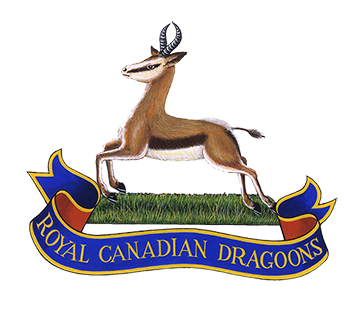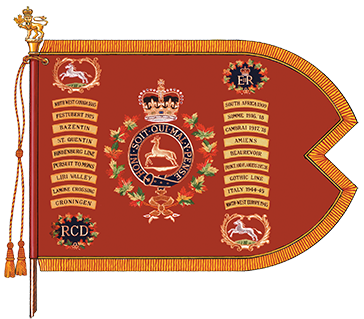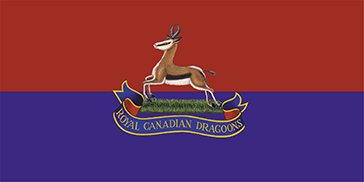The Royal Canadian Dragoons
The official lineage of The Royal Canadian Dragoons armour regiment.

Badge
Description
A springbok at speed on a grassy plain proper set upon a scroll Azure lined Gules, edged and inscribed ROYAL CANADIAN DRAGOONS in letters Or.
Symbolism
The bounding springbok commemorates the regiment's involvement in the South African War. "ROYAL CANADIAN DRAGOONS" is a form of the regimental title.
Motto
None
Marches
Mounted parades (Concerts and Mess)
Monsieur Beaucaire
Dismounted Parades
Light of Foot
Alliance
British Army
The Blues and Royals (Royal Horse Guards and 1st Dragoons)
Affiliation
The Governor General's Horse Guards
Guidon

Camp flag

Battle honours
North West Rebellion
NORTH WEST CANADA, 1885.
South African War
SOUTH AFRICA, 1900.
The First World War
FESTUBERT, 1915; SOMME, 1916, '18; Bazentin; Pozières; Flers-Courcelette; CAMBRAI, 1917, '18; St. Quentin; AMIENS; HINDENBURG LINE; St. Quentin Canal; Beaurevoir; PURSUIT TO MONS; FRANCE AND FLANDERS, 1915-18.
The Second World War
LIRI VALLEY; GOTHIC LINE; LAMONE CROSSING; Misano Ridge; Sant'Angelo in Salute; Fosso Vecchio; ITALY, 1944-1945; Groningen; Bad Zwischenahn; NORTH-WEST EUROPE, 1945.
Lineage
This Regular Force regiment originated on 21 December 1883 and incorporates the following regiment and mounted rifle corps.
The Royal Canadian Dragoons originated in Quebec City, Quebec on 21 December 1883, when the 'Cavalry School Corps' was authorized to be formed.Footnote 1 It was redesignated the 'Canadian Dragoons' on 14 May 1892.Footnote 2 On 27 June 1892, it was amalgamated with the 'Canadian Mounted Rifle Corps' (see below) retaining its designation.Footnote 3 It was redesignated: 'The Royal Canadian Dragoons' on 24 May 1893;Footnote 4 '1st Armoured Regiment (Royal Canadian Dragoons), RCAC' on 16 October 1946;Footnote 5 'Royal Canadian Dragoons (1st Armoured Regiment)' on 2 March 1949;Footnote 6 'Royal Canadian Dragoons' on 19 May 1958;Footnote 7 and 'The Royal Canadian Dragoons' on 12 January 1959.Footnote 8
The Canadian Mounted Rifle Corps originated in Winnipeg, Manitoba on 20 July 1885, when the 'School of Mounted Infantry' was authorized to be formed.Footnote 9 It was redesignated the 'Canadian Mounted Rifle Corps' on 7 August 1891.Footnote 10 On 27 June 1892, it was amalgamated with the 'Canadian Dragoons', as above.
Headquarters Location
Petawawa, Ontario
Operational history
North West Rebellion
The Cavalry School Corps mobilized its 'A Troop' for active service on 10 April 1885.Footnote 11 It served with the Alberta Column of the North West Field Force.Footnote 12 The troop was removed from active service on 18 September 1885.Footnote 13
South African War
'The Canadian Mounted Rifles' were authorized to be formed for active service on 20 December 1899.Footnote 14 On 28 December 1899 it was reorganized as two separate battalions, designated the '1st Battalion, Canadian Mounted Rifles' and the '2nd Battalion, The Canadian Mounted Rifles'.Footnote 15 The 1st Battalion was redesignated 'The Royal Canadian Dragoons (Special Service Force)' on 1 August 1900.Footnote 16 It embarked for South Africa on 21 February 1900,Footnote 17 where it fought as part of the '1st Brigade, 1st Mounted Infantry Corps' and Major-General Smith-Dorrien's column until its departure on 13 December 1900.Footnote 18 The overseas regiment was disbanded on 21 January 1901.Footnote 19
The First World War
The regiment was placed on active service on 6 August 1914 for instructional and camp administration duties.Footnote 20 On 14 September 1914 it mobilized 'The Royal Canadian Dragoons, CEF',Footnote 21 which embarked for England on 3 October 1914.Footnote 22 On 5 May 1915 it disembarked in France,Footnote 23 where it fought in an infantry role as part of 'Seely's Detachment', 1st Canadian Division.Footnote 24 On 24 January 1916, it resumed its cavalry role as part of the 1st Canadian Cavalry Brigade with whom it continued to fight in France and Flanders until the end of the war.Footnote 25 The overseas regiment was disbanded on 6 November 1920.Footnote 26
The Second World War
On 24 May 1940, the headquarters and one squadron were mobilized together with the headquarters and one squadron of the 'Lord Strathcona's Horse (Royal Canadians)' to form the '1st Canadian Motorcycle Regiment, CASF (RCD/LSH (RC))'.Footnote 27 On 21 September 1940, this regiment was redesignated 'Lord Strathcona's Horse (Royal Canadians) CASF' (see the chart for this unit).Footnote 28 Subsequently, the regiment mobilized 'The Royal Canadian Dragoons (Armoured Car Regiment), CASF' on 21 September 1940.Footnote 29 It was redesignated: '1st Armoured Car Regiment (The Royal Canadian Dragoons), CAC, CASF' on 11 February 1941;Footnote 30 '1st Armoured Car Regiment (The Royal Canadian Dragoons), CAC, CASF' on 15 October 1943;Footnote 31 and '1st Armoured Car Regiment (The Royal Canadian Dragoons), RCAC, CASF' on 2 August 1945.Footnote 32 It embarked for Britain on 13 November 1941.Footnote 33 The regiment landed in Sicily on 8 November 1943 and in Italy on 5 January 1944 as 1st Canadian Corps troops and eventually as a part of the 1st Canadian Infantry Division.Footnote 34 In March 1945 the regiment moved with the 1st Canadian Corps to North-West Europe, where it fought until the end of the war.Footnote 35 The overseas regiment was disbanded on 1 March 1946.Footnote 36
On 1 September 1945 a second Active Force component of the regiment was mobilized for service in the Pacific theatre of operations under the designation '2nd-1st Armoured Car Regiment (The Royal Canadian Dragoons), RCAC, CASF'.Footnote 37 It was redesignated: '2nd-1st Armoured Regiment (The Royal Canadian Dragoons), RCAC, CASF' on 15 November 1945;Footnote 38 and '1st Armoured Regiment (The Royal Canadian Dragoons), RCAC, CASF' on 1 March 1946.Footnote 39 On 27 June 1946 it was embodied in the Permanent Force.Footnote 40
Page details
- Date modified: